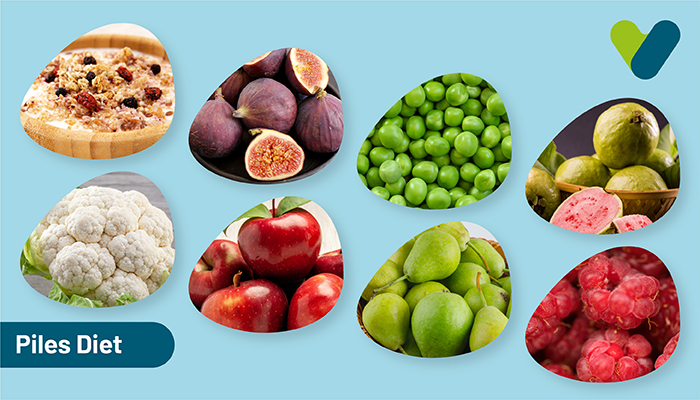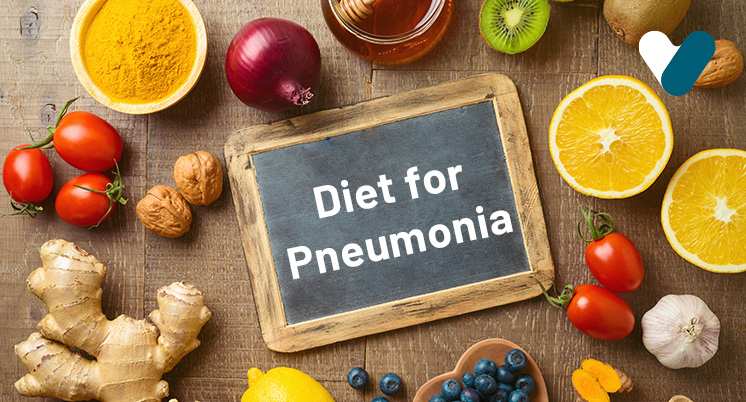The body’s digestive system plays a crucial part in the growth, development, and healthy life of a person from birth to death. One of the most common disorders of this system is piles, otherwise known as haemorrhoids. Piles are caused by extensive pressure exerted on the blood vessels in the anal region due to low-fibre diet and straining during bowel movements. The diet plays an important role in the prevention and treatment of piles. A list of food items to avoid in piles along with health tips and basic overview of the condition, including its symptoms, is presented here.
Types of piles
Piles or haemorrhoids are basically enlarged blood vessels in the anal region that can easily become irritated when additional pressure is applied. Chiefly, there are two types of haemorrhoids based on their location.- Internal haemorrhoids They occur inside the rectum (the last part of the large intestine that connects to the anus) and are usually not visible. Internal haemorrhoids can rupture during bowel movements and cause bleeding (sometimes after passing the stool). You may not necessarily feel pain in this case as there are very few pain receptors inside the rectum, but it can result in discomfort, pain, and further bleeding if the haemorrhoids prolapse or fall out of the rectum.
- External haemorrhoids They are located near the anus outside the rectum and can be more painful than internal ones during sitting, passing stool, or wiping the anus as the anus has comparatively more pain receptors.
Piles Symptoms
Piles or hemorrhoids are swollen veins in the rectal or anal area that cause a bunch of uncomfortable symptoms. The most common one is pain during or after bowel movements which can range from mild to sharp pain especially in severe cases. Itching and irritation around the anus is also common as the swollen veins can cause inflammation and sensitivity.Another symptom is swelling or a soft lump near the anus which can be painful to touch. Bleeding is a hallmark symptom of piles, you can see it as bright red blood on toilet paper, in the stool or in the toilet bowl usually during bowel movements. Some people may feel a constant feeling of fullness or pressure in the rectum which can be annoying.
Severe hemorrhoids can cause prolapse where the swollen veins protrude from the anal opening. This can lead to more complications like difficulty in cleaning the area or persistent pain. While these symptoms can be uncomfortable, they can be managed with lifestyle changes, over the counter meds and medical intervention when necessary. Early detection and treatment can prevent the condition from getting worse and improve the quality of life of those affected.
The following are the most common tell-tell signs that a person has piles:
- Bleeding or spotting on the underwear
- Burning sensation, discomfort, itching, and/or pain in the anal region
- Swelling around the anus
Piles And Food
The food you eat is digested in the stomach and intestines, and the leftover waste passes through the rectum and out of the anus. This cycle has a great impact on whether a person develops haemorrhoids or not and the improvement in their condition. A person who eats too little or too much fibre has an increased likelihood of having chronic constipation or diarrhoea, which are known for causing piles.The first thing a doctor will suggest is dietary adjustments to balance the level of fibre and other nutrients one consumes on a daily basis to treat and manage piles. There are certain foods to avoid with haemorrhoids that the doctor will advise a patient against, and there are certain foods for piles that improve this condition. Apart from altering the food, one should also opt for healthy eating habits (such as chewing properly and drinking plenty of water some time before and after eating) to make digestion easy.
Foods To Eat In Piles(Haemorrhoids)
The ideal piles diet consists of a balanced meal full of nutritious foods and vegetables with an adequate amount of fibre. Here is a list of high-fibre foods for piles:- Cereals with bran (bran is the high-fibre outer layer of cereals)
- Porridge (also known as wheat daliya)
- Fruits such as pear, apple, and guava, with their skin and banana
- Figs (anjeer), dates, raspberries, and prunes
- Vegetables such as green peas, collard greens (haak saag), sweet potato (shakarkandi), carrots, and cauliflower
- Coconut
- Lentils (dal) and beans such as kidney beans (rajma)
Foods To Avoid In Piles
The diet consumed today is much more processed than it used to be, which might not be the best option for people with piles. Current food trends combined with a highly sedentary lifestyle can make the condition worse for many individuals with haemorrhoids. Thus, you need to watch what you eat. Here’s a list of food items to avoid with haemorrhoids:- Processed and deep-fried food items Due to the preparation process, these food items contain fewer nutrients and a significant amount of sodium and unhealthy fats, which can lead to poor digestion.
- Spicy food If you have piles, it is likely that some of the haemorrhoids might get sore or start bleeding due to spicy food.
- Dairy products such as milk and cheese They can cause you to be gassy and constipated and trigger cramps in the stomach.
- Unripe fruits Unripe fruits may contain compounds that are known to irritate the gut and may cause constipation.
- Food items made with refined grains Grains have a naturally high-fibre outer covering—bran but refining them leads to the removal of this layer.
- Foods with high amounts of salt Sodium is known to cause bloating; this may affect your blood vessels.
- Excessive fibre Although a high-fibre diet is recommended in piles, taking too much fibre at once can cause the stool to form bulks and make it difficult to pass it.
- Iron supplements and certain medicines Please check with your doctor about any medication or supplements you are currently taking as they can cause constipation.
- Alcohol Alcohol is known to disrupt the digestive balance by dehydrating the gut, and it should be avoided in piles.
Piles (Haemorrhoids) Health Tips
Here are some tips to help you manage piles better.- Avoid wiping the anus with dry toilet paper or wipes with alcohol/perfume and use a damp towel or water to wash.
- Do not use perfumes or aerosol sprays near the anal region.
- Maintain proper hygiene without over-cleaning.
- Wear soft clothes that are not too tight to irritate the haemorrhoids.
- Use numbing creams (with lidocaine) for painful external haemorrhoids.
- Use a soft cushion to sit on instead of hard surfaces.
- Sit in warm water baths to smooth pain.
Treatment For Piles
Although piles go away on their own, you can seek medical treatment if the symptoms are too troublesome. Here are some the common treatment options used for piles:- Stopping the blood flow of the haemorrhoid so that it eventually shrinks and/or falls off by using methods such as: a. Rubber band litigation b. Sclerotherapy c. Laser treatment for haemorrhoids
- Removing the haemorrhoid through a surgery, piles surgery—haemorrhoidectomy. This is usually done with thrombosed haemorrhoids (ones that have blood clotting inside them).
- Draining the haemorrhoid and causing it to shrink is another way thrombosed and large haemorrhoids are treated.
Piles Diagnosis
Piles is usually diagnosed with a physical examination in which the doctor checks your anus and rectum. Additionally, the doctor might order some tests to eliminate the possibility of other diseases that causes similar symptoms (such as colon cancer, anus fissures, and anal fistulas) The doctor might also insert anoscope (a tube with light and camera) inside your rectum to check the inside walls.How to prevent piles?
Although piles are quite common, and most people develop this condition in their life, piles can be prevented by following some of the tips mentioned here:- Consume adequate amounts of water and fibre.
- Consult a doctor to improve the functioning of the digestive system to avoid constipation and diarrhoea.
- Do not strain too hard during bowel movements and go to the toilet only if needed to.
- Avoid heavy lifting.
Diet Chart For Piles Patient
Hemorrhoids or Piles are the inflamed blood vessels across the anus. Normally, various factors are involved in the development of the Piles. Pressure in the veins in the lower rectum is the main cause of pile formation. Maintaining a proper diet chart is suitable for easily reducing the Piles even without any hassle. Proper diet plans are essential for healing damaged tissue in the body. Eating a high-fiber diet is important for having a good effect. Follow the below diet schedule to get relief from Piles.- Early Morning – Take 1 tsp Flax seed or Aloe Vera juice with Warm water
- Breakfast - Take Veg Idli or Oats with Dal
- Mid-morning – Drink Coconut water or Fruit juice
- Lunch – Eat Brown rice with Vegetables with Dal
- Evening - Drink Homemade soup or Herbal tea
- Dinner - Eat Chapati and Vegetable with Dal
Piles Diet : Final Word
Eating high-fibre food for piles management is highly recommended as this diet can alleviate troubling piles symptoms including pain and irritation. The diet is a key instrument in managing this condition better and recover quickly. Besides, people can make some changes in their lifestyle and toilet habits as well. They should avoid delay in going to the bathroom as this can make them constipated. In addition, one can use a small stool to prop up your feet while sitting on the toilet; the squatting position helps the body to easily pass poo.References:
- Eating, Diet, & Nutrition for Hemorrhoids. National Institute of Diabetes and Digestive and Kidney Diseases (NIDDK) [Internet]. https://www.niddk.nih.gov/health-information/digestive-diseases/hemorrhoids/eating-diet-nutrition. Accessed Jan 20, 2023.
- Hemorrhoids Treatment & Management. Medscape [Internet]. https://emedicine.medscape.com/article/775407-treatment. Accessed Jan 25, 2023.
- Which foods to eat and avoid to help treat and prevent piles. Medical News Today [Internet]. https://www.medicalnewstoday.com/articles/hemorrhoids-high-fiber-diet. Accessed Jan 30, 2023.
- Five Food People With Hemorrhoids Should Avoid. HealthMatch[Internet]. https://healthmatch.io/hemorrhoids/5-foods-to-avoid-with-hemorrhoids. Accessed Jan 22, 2023.


